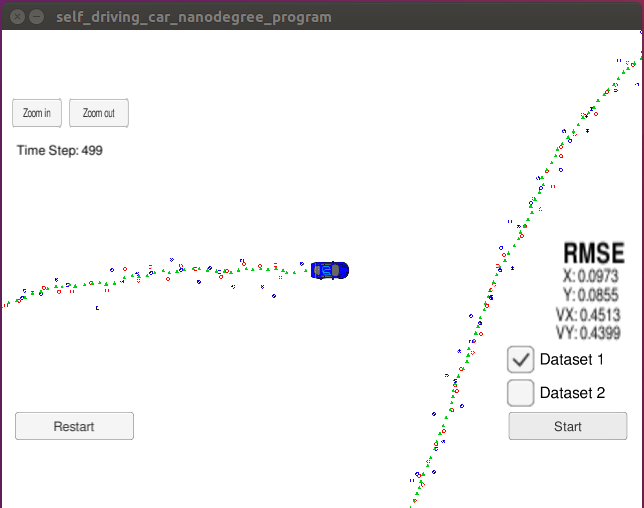The goals/steps of this project are the following:
- Track an object’s position and velocity by implementing an Extended Kalman Filter in C++
- Ensure that the projects compiles on any platform
- Test the Kalman filter in the Term 2 Simulator provided by Udacity
- Evaluate the performance of our algorithm
- Summarize the results with a written report
My program can be built and run by doing the following:
mkdir build(from the project's top directory)cd buildcmake ..make./ExtendedKF
I tested my Kalman Filter algorithm in the simulator with Dataset 1. I evaluated its performance, using the accuracy metric of RMSE (Root Mean Squared Error).
RMSE measures the deviation of the estimated state from the true state. The lower are the RMSE values for our px, py, vx, vy output coordinates, the higher is our estimation accuracy. The RMSE calculation is being handled in the tools.cpp file by the CalculateRMSE function, which the main.cpp is calling. In the picture below you can see my RMSE results.
For implementing the algorithm, I followed the steps as described in the course, and I used the starter code as provided by Udacity. All the programming files that we need are located in the src folder of the project. In the src folder, you can find the:
Eigenlibrary which helps us do all the matrix math involved in this project,FusionEKF.cppand its header fileFusionEKF.h, which handle the high-level of the filter,json.hppwhich is for the simulatoruWebSocketIOinterface,kalman_filter.cpp, in which we implement all the equations of our Kalman Filter, and its corresponding header filekalman_filter.h,- the main program file of our project
main.cpp, which does all the interfacing between our algorithm and the simulator, measurement_package.hwhich helps passing all the measurement data to the filter,- and finally
tools.cpp(and its header filetools.h) where we implement the calculations of the jacobian matrixHjand our metric of accuracy RMSE.
At first, I initialized variables and matrices in the FusionEKF class constructor (lines 17-58 of FusionEKF.cpp). Specifically, I set the H_laser_ measurement matrix for LiDAR, I initialized the transition matrix F_ and the covariance matrix P_, as well as the acceleration noise components, all as described in the lessons.
Then moving on to the ProcessMeasurement function (lines 65-121 of FusionEKF.cpp), we initialize the state vector ekf.x_ and overwrite its first two components based on whether the measurement is coming from the radar or the laser. As far as the radar is concerned, I have to convert from polar to cartesian coordinates before. Lastly, I set the state the transition matrix F_ and the state covariance matrix P_ as given in classroom.
For the prediction step, first I compute the dt between current and previous measurements, and I adjust the F_ matrix, so that the time is integrated. The process covariance matrix Q_ is calculated as well, taking into consideration the noise_ax and noise_ay (lines 136-152 of FusionEKF.cpp).
Then the Predict() function is called, for I which I had to complete its definition by adding the corresponding equations for the prediction step of the kalman filter (lines 24-33 of kalman_filter.cpp). Then according to the type of sensor data, the algorithm proceeds to the update step.
The update step of the algorithm is calculated differently, based on the type of sensor data. If the measurement comes from a LiDAR, then the update step will use the Kalman Filter equations (see lines 35-53 of kalman_filter.cpp). If the measurement comes from a radar though, then the Jacobian matrix should be calculated instead, so as to linearize the equations. See lines 167-184 of FusionEKF.cpp for the calling of UpdateEKF() and Update(). The UpdateEKF() uses the extended kalman filter equations (lines 55-88 of the kalman_filter.cpp).
In the UpdateEKF() function, I included normalization of the radar measurements, so that the angle phi in the y vector is adjusted between -pi and pi (lines 71-75 of the kalman_filter.cpp).
For the calculation of the Jacobian matrix the CalculateJacobian() function is used, which is defined in the tools.cp file (lines 52-83).
